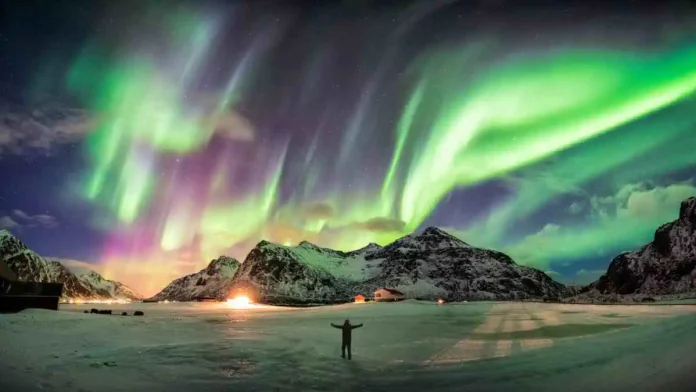1. The Enchanting Display of Aurora Borealis
Witnessing the Earth’s spectacular auroras is a breathtaking experience, and in early November 2023, a stunning spectacle unfolded across the skies of North America and Europe. The solar storm that propelled high-energy particles into the Earth’s upper atmosphere created an awe-inspiring phenomenon—vivid, colorful auroras dancing gracefully across the firmament.
2. Captivating Images Painted Across the Sky
Eager skywatchers and photography enthusiasts in North America and Europe shared enthralling snapshots of the aurora borealis, also known as the northern lights, on various social media platforms. These intense geomagnetic storms transformed the night sky into a canvas adorned with vibrant bands of light, captivating the world with its mesmerizing beauty.
3. A Glimpse Through the Satellite’s Lens
In the early hours of November 5, 2023, the VIIRS sensor on the NOAA-NASA Suomi NPP satellite captured astounding aurora satellite imagery over western Canada at 3:23 AM local time. The vividness of the aurora near Edmonton, Canada was so remarkable that it nearly saturated the satellite sensor. This celestial spectacle persisted, gracing the night sky over Glasgow, Montana, with ethereal hues of pink and green. Even as far south as Texas, faint glimpses of this natural wonder were visible, making this event a rare and captivating sight.
4. The Science Behind Auroras
The genesis of these awe-inspiring auroras traces back to the sun’s release of charged particles during solar flares, coronal mass ejections, or active solar winds. As these solar particles interact with the magnetosphere and alter Earth’s magnetic field structure, some accelerate into the upper atmosphere, exciting nitrogen and oxygen molecules. The resultant release of photons manifests as the spellbinding phenomenon of auroras.
5. Understanding the Celestial Symphony
According to the US National Oceanic and Atmospheric Administration’s Space Weather Prediction Center, the November 5th to 6th auroras were triggered by multiple coronal mass ejections—a process involving the ejection of magnetized plasma from the solar corona. These events, along with high-energy waves entering Earth’s upper atmosphere, sparked intense geomagnetic storms, contributing to the enchanting display witnessed across the skies.
6. Astronaut’s View from Above
A week before the celestial event, an astronaut aboard the International Space Station captured another mesmerizing aurora photo while orbiting above Utah. This display, observed 260 miles above Earth, was attributed by the Space Weather Prediction Center to a coronal hole rotating towards Earth. These areas of relatively cooler material on the sun’s surface release material in the form of high-speed streams, contributing to such captivating cosmic events.
7. Engage in Citizen Science
For those passionate about observing auroras, contributing to citizen science through Aurorasaurus offers an exciting opportunity. By visiting Aurorasaurus, individuals can actively participate in tracking auroras worldwide. The project’s collaborative approach, supported by the New Mexico Consortium, the US National Science Foundation, and NASA, invites citizen scientists to report sightings on the website and social media. Verified sightings serve as invaluable data points, aiding scientific analysis and enhancing space weather models.
Immerse yourself in the wonders of nature’s celestial ballet, marvel at the brilliance of the auroras, and contribute to scientific discovery by becoming a part of this fascinating citizen science initiative.
Let the magnificence of the auroras continue to inspire wonder and curiosity in our hearts and minds.
Related:


[…] Spectacular Aurora Borealis: Nature’s Mesmerizing Light Show […]
[…] Spectacular Aurora Borealis: Nature’s Mesmerizing Light Show […]